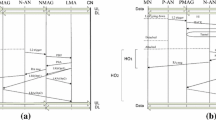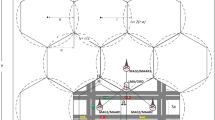Abstract
Proxy Mobile IPv6 has been developed from the concept of network-based mobility support protocol in the Internet Engineering Task Force. The recently published specification of Proxy Mobile IPv6 only focuses on the mobility support without a mobile host’s participation in the mobility signaling. Then, route optimization issues are left in the basket for further works. In this paper, we explore the existing route optimization proposals that are analyzed and matched against a list of functional and operational angles. Then, the chosen two route optimization proposals are evaluated in terms of signaling cost, packet delivery cost, total cost, and service blocking probability. Through the provided analysis results, we demonstrate that route optimization solves the ineffective routing path problem when the mobile host communicates with its corresponding host and argue that the scalability of Proxy Mobile IPv6 architecture is also improved due to the distributed routing path. In addition, the cost model developed in this paper would be a reference model in order to facilitate decision making for further route optimization design.










Similar content being viewed by others
Notes
The recently chartered Network-Based Mobility Extension (NETEXT) working group involves a development of RO for PMIPv6 as a working item. As indicated in [19], the standardization of RO would be submitted to the Internet Engineering Steering Group for publication as a proposed standard Request for Comments by April 2010.
The document entitled “Problem Statement and Requirements for Route Optimization in PMIPv6” was a joint effort of several contributors who were also authors for RO proposals.
In [9], the identifiers for MH and CH have not been considered in the CB update message. However, these identifiers should be contained in the message because the identifier is used to distinguish each node in PMIPv6 [5]. In addition, the identifier-based discernment is proper at multihoming scenarios.
In [23], we have proposed a paging extension and developed the paging cost model for PMIPv6.
References
Johnson D, Perkins C, Arkko J (2004) Mobility support in IPv6. IETF RFC 3775
Lee J-H, Lim H-J, Chung T-M (2008) A competent global mobility support scheme in NETLMM. Int J Electron Commun. doi:10.1016/j.aeue.2008.07.010
Kempf J (ed) (2007) Problem statement for network-based localized mobility management (NETLMM). IETF RFC 4830
Kempf J (ed) (2007) Goals for network-based localized mobility management (NETLMM). IETF RFC 4831
Gundavelli S, Leung K, Devarapalli V, Chowdhury K, Patil B (2008) Proxy Mobile IPv6. IETF RFC 5213
Liebsch M, Le L, Abeille J (2007) Route optimization for Proxy Mobile IPv6. draft-abeille-netlmm-proxymip6ro-01 (work in progress)
Jeong S, Wakikawa R (2007) Route optimization support for Proxy Mobile IPv6 (PMIPv6). draft-jeong-netlmm-ro-support-for-pmip6-00 (work in progress)
Sarikaya B, Qin A, Huang A, Wu W (2008) PMIPv6 route optimization protocol. draft-qin-netlmm-pmipro-00 (work in progress)
Dutta A, Das S, Yokora H, Chiba T, Schulzrinne H (2008) ProxyMIP extension for Inter-MAG route optimization. draft-dutta-netlmm-pmipro-01 (work in progress)
NETLMM working group (2009) http://www.ietf.org/html.charters/netlmm-charter.html. Accessed March 2009
Koodli G (2005) Fast handovers for mobile IPv6. RFC 4068
Soliman H, Castelluccia C, ElMalki K, Bellier L (2008) Hierarchical mobile IPv6 (HMIPv6) mobility management. IETF RFC 5380
Lee J-H, Han Y-H, Gundavelli S, Chung T-M (2009) A comparative performance analysis on Hierarchical Mobile IPv6 and Proxy Mobile IPv6. Telecommun Syst 41(4):279–292
Wakikawa R, Gundavelli S (2009) IPv4 support for Proxy Mobile IPv6. draft-ietf-netlmm-pmip6-ipv4-support-09 (work in progress)
Muhanna A, Khalil M, Gundavelli S, Leung K (2009) GRE key option for Proxy Mobile IPv6. draft-ietf-netlmm-grekey-option-06 (work in progress)
Devarapalli V, Koodli R, Lim H, Kant N, Krishnan S, Laganier J (2009) Heartbeat mechanism for Proxy Mobile IPv6. draft-ietf-netlmm-pmipv6-heartbeat-05 (work in progress)
Giaretta G (2009) Interactions between PMIPv6 and MIPv6: scenarios and related issues. draft-ietf-netlmm-mip-interactions-02 (work in progress)
Vidya Narayanan’s announcement (2009) Next steps in NETLMM. http://www.ietf.org/mail-archive/web/netlmm/current/msg05943.html. Accessed March 2009
NETEXT working group (2009) http://www.ietf.org/dyn/wg/charter/netext-charter.html. Accessed August 2009
Jeong S, Vogt C, Wakikawa R, Liebsch M, Sugimoto S, Sarikaya B (2009) Problem statement and requirements for route optimization in PMIPv6. draft-jeong-netlmm-pmipv6-roreq-01 (work in progress)
Arkko J, Vogt C, Haddad W (2007) Enhanced route optimization for mobile IPv6. IETF RFC 4866
Zhang X, Castellanos J, Campbell A (2002) P-MIP: paging extensions for mobile IP. ACM Mob Netw Appl 7(2):127–141
Lee J-H, Chung T-M, Pack S, Gundavelli S (2008) Shall we apply paging technologies to Proxy Mobile IPv6? In: Proceedings of ACM international workshop on mobility in the evolving internet architecture (MobiArch) 2008, pp 37–42
Baumann FV, Niemegeers IG (1994) An evaluation of location management procedures. In: Proceedings of IEEE international conference on universal personal communications (UPC) 1994, pp 359–364
Makaya C, Pierre S (2008) An analytical framework for performance evaluation of IPv6-based mobility management protocols. IEEE Trans Wirel Commun 7(3):972–983
Lee J-H, Chung T-M, Gundavelli S (2008) A comparative signaling cost analysis of Hierarchical Mobile IPv6 and Proxy Mobile IPv6. In: Proceedings of IEEE international symposium on personal, indoor and mobile radio communications (PIMRC) 2008, pp 1–6
Lo S-C, Lee G, Chen W-T, Liu J-C (2004) Architecture for mobility and QoS support in all-IP wireless networks. IEEE J Sel Areas Commun 22(4):691–705
Pack S, Kwon T, Choi Y (2007) A performance comparison of mobility anchor point selection schemes in Hierarchical Mobile IPv6 networks. Comput Networks 51(6):1630–1642
Kleinrock L (1975) Queueing systems: theory, vol 1. Wiley Interscience, New York
Lin J-W, Arul J (2003) An efficient fault-tolerant approach for mobile IP in wireless systems. IEEE Trans Mob Comput 2(3):207–220
Lee J-H, Han B-J, Chung T-M, Lim H-J (2008) Network mobility basic support within Proxy Mobile IPv6: scenarios and analysis. draft-jhlee-netlmm-nemo-scenarios-01 (work in progress)
Lee J-H, Gundavelli S, Chung T-M (2009) A performance analysis on route optimization for Proxy Mobile IPv6. In: Proceedings of IEEE international conference on communications (ICC) 2009
Acknowledgements
The authors are thankful to the anonymous reviewers for their valuable suggestions for improving this paper. Special thanks also goes to Sri Gundavelli for his invaluable thoughtfulness and input on a preliminary version of this paper [32].
Author information
Authors and Affiliations
Corresponding author
Rights and permissions
About this article
Cite this article
Lee, JH., Chung, TM. How much do we gain by introducing route optimization in Proxy Mobile IPv6 networks?. Ann. Telecommun. 65, 233–246 (2010). https://doi.org/10.1007/s12243-009-0127-9
Received:
Accepted:
Published:
Issue Date:
DOI: https://doi.org/10.1007/s12243-009-0127-9




